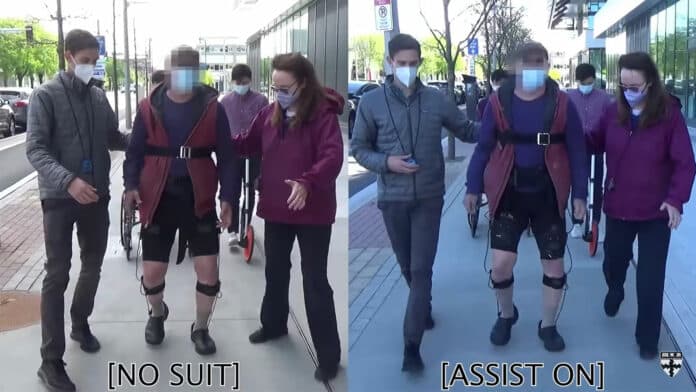Freezing is one of the most common and debilitating symptoms of Parkinson’s disease that affects millions of people worldwide. When individuals with Parkinson’s disease freeze, they suddenly lose the ability to move their feet, which can lead to falls. While there are treatments available, including pharmacological, surgical, or behavioral therapies, none of them are particularly effective in addressing this condition.
Researchers from the Harvard John A. Paulson School of Engineering and Applied Sciences and the Boston University Sargent College of Health & Rehabilitation Sciences have recently developed a soft, wearable robot that can help people with Parkinson’s walk without freezing.
The robot garment is worn around the hips and thighs and gives a gentle push to the hips as the leg swings, enabling the patient to achieve a longer stride. According to the researchers, the device completely eliminated the participant’s freezing while walking indoors, allowing them to walk faster and further than they could without the garment’s help.
“We found that just a small amount of mechanical assistance from our soft robotic apparel delivered instantaneous effects and consistently improved walking across a range of conditions for the individual in our study,” said Conor Walsh, the Paul A. Maeder Professor of Engineering and Applied Sciences at SEAS
The research team collaborated closely with Terry Ellis, professor and Physical Therapy Department chair and director of the Center for Neurorehabilitation at Boston University, and spent six months working with a 73-year-old man with Parkinson’s disease.
Despite using both surgical and pharmacologic treatments, this patient endured substantial and incapacitating freezing episodes more than ten times a day, causing him to fall frequently. This made it difficult for him to walk and move around his community, and he relied on a scooter for outdoor mobility.
The researchers used the same approach from their prior research into assistive and rehabilitative robotic technologies, but this time to address freezing. The wearable device uses cable-driven actuators and sensors worn around the waist and thighs. By collecting motion data from the sensors and estimating the phase of the gait, algorithms generate assistive forces that work in harmony with muscle movement.
The effect was quite remarkable. Without any special training, the patient was able to walk without any freezing indoors and with only occasional episodes outdoors. He was also able to walk and talk without freezing, a rarity without the device.
“The suit helps me take longer steps, and when it is not active, I notice I drag my feet much more. It has really helped me, and I feel it is a positive step forward. It could help me to walk longer and maintain the quality of my life,” the participant told researchers.
The device could also be used to better understand the mechanisms of gait freezing, which is poorly understood.
